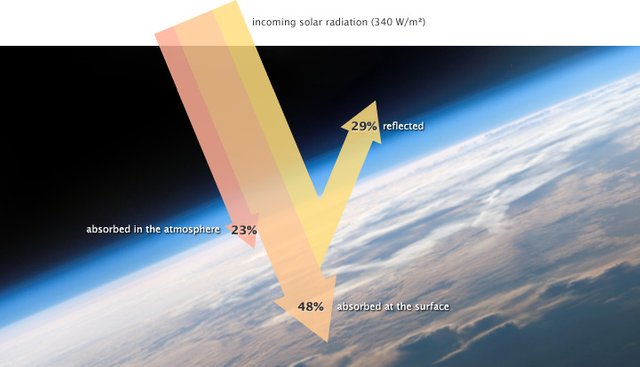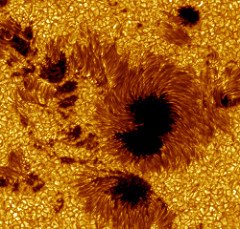Let's talk about the heat budget of the earth :understanding the need for stability
Jupiter is a very beautiful planet to behold, and a peep at the animation of Jupiter will reveal belts of moving bodies, these are gases whirling at a very high speed. Hence, Jupiter is viewed as a gas giant, with a weight of almost one thousandth of that of the sun. But Jupiter exaggerated the earth’s atmospheric conditions because earth too is surrounded by gases though not as pronounced as that of Jupiter.

Image source NASA. Creative commons license.
The earth receives an abundant of energy from the sun and it is very much evident when we look at the plants in our environment. If the plants can carry out photosynthesis as a result of energy from the sun, I think there must be a way of equally sending this energy back to the sun or at least out of the earth since the absence of this would imply serious imbalance and would definitely have negative implications on the earth as a planet.
If we can view the earth as just a ball, there has been no point in time this ball gets all hot or all cold. This is because different parts of the earth does not receive energy from the sun at the same time. An energy gain by one part of the system would mean an energy loss for another part of the same system and the sum of all these energy losses and gains would always give the same value which implies there must be energy balance for the earth to exist.
Solar Insolation
Broadly, we have two kinds of system, the type of system that interacts with its environment and the type that does not interact with its environment. The former is known as open system while the later is known as a closed system. The earth is constantly in contact with its surroundings, constantly exchanging energies.
The total amount of energy reaching the earth from the sun is termed insolation. The earth is approximately 93 million miles from the sun with a diameter of about 1/109 of that of the sun making the total energy reaching the earth’s atmosphere to be about 1.94 calories/Cm2/min which is a small fraction of the energy leaving the sun's surface. But how did the sun manufacture all these energy?
The simple answer is nuclear reaction. This reaction takes place in the core of the sun and it involves the conversion of hydrogen atoms into helium molecules releasing a tremendous amount of energy. This energy travels through the space in the form of electromagnetic disturbance making the energy transfer to be of the type radiation. This radiation has varying degree depending on the distance between the earth and the sun. Alphelion and Perihelion are the two words used to describe the extreme distances between the earth and the sun.
While the former represents the farthest position of the earth from the sun (this usually occur at the first week of January), the later represents closest position of the earth to the sun (this usually occur first week of July). The effect of these distances are not really felt because other environmental factors comes in to balance the energy composition of the earth, these factors land and water body and atmospheric distributions.
))
Due to the shape of the earth, energy are not distributed uniformly throughout the earth. Image source NASA. Creative commons license.
Solar insolation in an area of the earth varies greatly and so many factors are responsible for these un-uniform distribution of sun’s energy on earth. It is physically evident that the amount of sun rays in a place depends on the time of the day, the time of the year and also the particular season being experienced.
These factors includes earth’s rotation and revolution, the inclination of the ray of sun, atmospheric covering, how long the day is, changes within sun system and the surface orientation.
Effects of rotation and revolution of earth
We experience day and night as a result of earth’s rotation and revolution. It is obvious we “feel” the sun’s intensity most during the day time. As already stated, the distance between the earth and the sun are not constant and this is because the earth’s orbit is elliptical. These extreme positions; the perihelion and the aphelion, have little impact on the earth’s surface since other environmental factors comes in to annul the effects of earth’s position.
))
The earth's rotation axis. Credit: Flickr. A CC by 2.0 license. Contributed by Siyavula Education
However, the rotation of the earth along its axis has a great impact on the amount of energy reaching a particular place on the earth’s surface. With respect to the plane of earth’s orbit, the earth makes an angle of about 66o as it orbits the energy ball. This tilting of the earth determines the seasons we experience at a particular time of the year.
Effects of length of the day and atmospheric cover on insolation
The length of the day during winter is not the same as the length of the day during summer. The longer the length of the day, the higher the amount of energy received such area from the sun. This variation in the length of the day is usually due the angle of tilt of the earth and also the earth’s latitude. These variations though are constant at the earth’s equator. As we move farther away from the equator, the length of the day either increases or decreases but certainly not constant.

With every other environmental factors kept constant, an area experiences maximum energy from the sun at mid day. Image source NASA. Creative commons license.
It also evident that the amount of sun rays reaching the earth when it is raining is quite low. Most of the energies reaching the earth’s surface do so as a wave with very short wavelength. For this reason, the atmosphere is naturally designed to allow energies with short wavelength. The intensity of sun’s energy reaching earth’s surface is influenced by the transparency of earth’s atmosphere. This transparency is also determined by the amount of cloud cover which has the ability to absorb some of the sun’s energy before it reaches the surface.
Effects of solar variation and earth's surface orientation on insolation
))
Sun spots. Image source Flickr. A CC by 2.0 license. Contributed by NASA Goddard Space Flight Center
The effect of solar variation and earth surface orientation possess the least impact on insolation. The periodic change of the amount of energy leaving the sun’s photosphere is known as solar variation. Normally, sunspots are dark bodies which periodically appear on the surface of the sun.
Increase in the amount of this dark spots also implies increase in the amount of energy leaving the sun’s surface but as already stated, this has least effect on the amount of energy reaching the earth as some layers in the earth’s atmosphere ensures that much dangerous radiations would not reach the earth’s surface.
Also the orientation of the earth’s surface affects the amount of energy reaching such surface. The changes in the orientation of earth’s surface creates effects such as local gradients of solar insolation, hence, agricultural activities are more on slopes that are facing the sun; usually in the southern part of northern hemisphere.
How the earth surface gets heated up and also cools off
If we take a look at ourselves as humans, there are ways and so many things we do in order to take good care of ourselves for the sake of maintaining a healthy self. In the same way the earth as a body on its own knows how to regulate its temperature in order to maintain life in it.

The heat absorbed by the earth's surface still escapes through various means. Image source NASA. Creative commons license.
The sun plays a vital role in helping to maintain this for earth. When the sun shines during the day, a lot of energy is being dispensed on the earth’s surface of which most of these energy if totally dispensed on the earth’s surface will spell danger on all forms of life on earth. As a result of these, the atmosphere helps to scatter most of the energy even before it reaches earth’s surface so that the heat and radiation from the suns wave will be reduced thereby preventing a harsh temperature here on earth.
Surfaces that are heated up tend to give out the heat they have accumulated to another body as long as the other body is not at the same temperature with the initial body and this transfer of heat can be said to be conduction of heat. The air helps to circulate heat from one place to another in an upward or side movement.
When the surrounding air in the atmosphere is heated up by the rays of the sun, the energy level increases in the air and the air begins to go up because heated air is lighter in weight than cool air and that is why the air can expand as it goes up therefore causing the cooler air to come down in a convective way. The atmospheric air can also expand in a horizontal manner thereby releasing energy to the earth’s atmosphere in an advective way.
So what is the heat budget of the earth’s atmosphere?
Just like I said earlier, the amount of incoming solar energy emanating from the suns ray must be the same amount of heat energy that leaves the earth. The amount that is absorbed into different layers of the atmosphere must be reflected out into the atmosphere and as a result of these energy changes ,there must be a balance in the energy level of the earth’s atmosphere and this balance can be referred to as the heat budget of the earth.
As the earth is heated up, turbulent heat loss occurs too along the troposphere even as insolation takes place in the atmosphere and the total sum of all reflected energy in the atmosphere is known as the earth’s albedo. This is why dark surfaces or layers tend to absorb much heat than light or bright surfaces.

The earth's energy budget. Image source Wikimedia. A creative commons license. Contributed by Robert Simmon
In the tropical regions for example, the presence of the covered crops and tress in the region makes the region to be able to reflect energy from the sun back to the atmosphere because of its vast vegetal cover which does not allow the rays of sun to get to the ground and heat the ground up and that is why temperature in such areas are low and aids the habitation of so many forms of life.
Unlike the arid and desert regions that have little or no tree and vegetal cover to redirect the rays of the sun. Such areas are heated up directly thereby causing the temperature of these regions to be very high and as such does not aid all forms of life.
Conclusion
Since the earth’s atmosphere needs to be in check at all times, it is important to know that there must be a balance in all the energy from the sun coming into the earth and all the terrestrial energy leaving the earth’s surface as well. And this is because the atmosphere helps to absorb, scatter and also reflect this energy which in turn helps maintain average temperature on earth.
The nature of the surface of any area in the world affects the heat budget of the earth and this is because the solar heating occurs on surfaces where the heat is absorbed, the angle of inclination of the sun and the effect of climate change all play a vital role in controlling the heat budget of the earth.
The activity of man also affects the heat balance of the earth for example, urban regions experience more exposure to the suns ray because of little or no vegetal cover that can help absorb the heat. And also industrial activities of man has also affected the heat budget of the earth. Constant release of greenhouse gases which depletes our ozone layer also affects the heat budget of the earth.
Let’s keep our earth green and save the word.
Till I come your way next time, Keep steeming and keep winning.
REFERENCES
- Earth's energy budget -Wikipedia
- The Heating And Cooling Of The Atmosphere Of The Earth -Principia-scientific
- emperature Distribution on Earth & Heat Budget -pmfias
If you write STEM (Science, Technology, Engineering, and Mathematics) related posts, consider joining #steemSTEM on steemit chat or discord here. If you are from Nigeria, you may want to include the #stemng tag in your post. You can visit this blog by @stemng for more details. You can also check this blog post by @steemstem here and this guidelines here for help on how to be a member of @steemstem. Please also check this blog post from @steemstem on proper use of images devoid of copyright issues here.

))
Nice one @prettyprecy, I want ask is earth's energy still balanced with the current global warming?
It's really not balanced for now because of the depleting state of our ozone layers. Solar energy entering into the earths atmosphere now is more and that is why we are currently experiencing global warming. Well, the amount of insolation differ from region to region. Arid regions experience more hear then the tropics.
You received a 10.0% upvote since you are not yet a member of geopolis and wrote in the category of "geography".
To read more about us and what we do, click here.
https://steemit.com/geopolis/@geopolis/geopolis-the-community-for-global-sciences-update-4
Very detailed. Now I know why desert areas are very hot in comparison to tropical regions despite situated on the same equator line, in which both should receive the same amount of heat. Thanks for the great write up :)
You are welcome, I'm glad you learnt something.
Resteemed your article. This article was resteemed because you are part of the New Steemians project. You can learn more about it here: https://steemit.com/introduceyourself/@gaman/new-steemians-project-launch
The insolation of a given area is of utmost importance for the solar power energy users. We all want a high w/m2 solar power to enjoy a higher harvest. Good job here.
Yes that's true and for the fact that its a renewable energy source.
Thanks @greenrun for stopping by
Congratulations @prettyprecy! You received a personal award!
Click here to view your Board
Congratulations @prettyprecy! You received a personal award!
You can view your badges on your Steem Board and compare to others on the Steem Ranking
Vote for @Steemitboard as a witness to get one more award and increased upvotes!